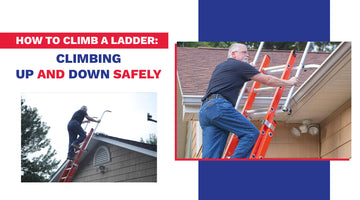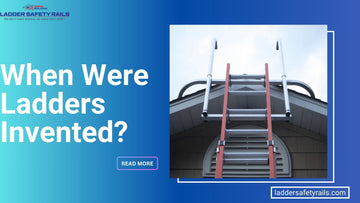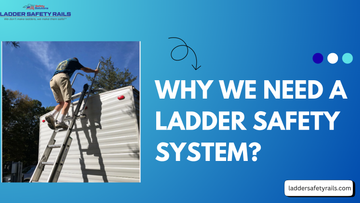
Ladders are an essential tool for many of us, whether we're reaching high shelves, fixing a light fixture, or tackling home improvement projects. However, using a ladder improperly can lead to accidents and injuries. Climbing up and down a ladder might seem like a simple task, but it's crucial to do it safely.
In this guide, we will explore the steps you should take to ensure your ladder usage is secure, covering what you need to determine before using a ladder, how to climb up and down safely, and what not to do when using a ladder.
What Should You Determine Before Using a Ladder?
Before you even think about stepping onto a ladder, there are several crucial considerations to keep in mind. These precautions will help you avoid common ladder-related accidents:
Set the Ladder at a 75° Angle with the Ground
One of the most critical factors when using a ladder is its angle. You should set up your ladder at a 75-degree angle with the ground. This angle provides the optimal balance between stability and reach. To achieve this, follow these steps:
-
Position the ladder: Place the base of the ladder one foot away from the surface it rests against for every four feet of ladder height.
- Use the 1:4 rule: For example, if you're working with a 12-foot ladder, set the base three feet away from the wall or surface you're leaning it against.
- Check the angle: Ensure that the angle between the ladder and the ground is approximately 75 degrees.
A ladder that's too steep or too shallow can easily tip over, leading to accidents and injuries. By following the 75-degree rule, you create a secure foundation for your ladder.
Make Sure the Feet Are Secure
Ladder stability starts from the ground up. Before climbing the ladder, ensure that the ladder's feet are secure:

- Inspect the feet: Check the ladder's feet for any damage or wear. The feet should be in good condition, with no missing or worn-out components.
- Choose the right feet: Some ladders come with different types of feet for various surfaces. Ensure you're using the appropriate type of feet for your work environment.
- Clean the surface: Make sure the floor or ground where you place the ladder is clean and free from debris. Small stones or uneven surfaces can undermine stability.
Securing the ladder's feet properly helps prevent slips and accidents.
Make Sure the Top of the Ladder Is Secure
Ladder stability doesn't stop at the bottom. The top of the ladder should also be secure. Here's what you need to do:

- Inspect the top: Examine the top of the ladder, where it contacts the wall or surface. Ensure it's in good condition and free from any damage or deformities.
-
Use ladder levelers: If you're working on uneven terrain, consider using ladder levelers or stabilizers to maintain a level working surface. These accessories can be a game-changer when it comes to ladder safety.
- Secure the top: If possible, fasten the top of the ladder to a solid, fixed point to provide additional stability. This prevents the ladder from sliding sideways.
A secure top ensures the ladder won't wobble or move when you're on it.
Climb the Ladder Maintaining Three Points of Contact
When you start ascending or descending a ladder, it's crucial to maintain three points of contact at all times. Three points of contact mean that you always have two hands and one foot, or two feet and one hand, in contact with the ladder. This technique helps you stay balanced and reduces the risk of falling. Here's how to do it:

-
Use both hands: Always keep both hands on the ladder's rungs as you climb up or down.
- Wear appropriate footwear: Ensure your shoes or boots provide good traction to prevent slipping on the ladder's rungs.
- Move one step at a time: Don't rush. Ascend or descend one step at a time, keeping three points of contact throughout.
Remember, safety should always come before speed when climbing a ladder.
What Should You Not Do When Climbing Up or Down a Ladder?
Equally important as what you should do when climbing a ladder is what you should avoid. Here are some critical ladder safety tips to keep in mind:
Utilize Accessories to Help Stabilize the Top of the Ladder
If you're concerned about ladder stability at the top, there are accessories available to help. For instance, ladder stabilizers or stand-off arms can be used to increase the ladder's reach while keeping the top securely in place. These accessories provide additional points of contact with the wall or surface, enhancing stability.
At Ladder Safety Rails, we offer ladder safety products designed to make your ladder use as safe as possible. Our ladder stabilizer and other accessories are built to the highest standards, ensuring your safety is our top priority.
Avoid Aluminum Ladders When Working with Electricity
Aluminum ladders are popular due to their lightweight and corrosion-resistant properties. However, they should be avoided when working near electricity. Aluminum is an excellent conductor of electricity, and using an aluminum ladder near live wires or electrical equipment can be extremely dangerous. In such cases, opt for a fiberglass ladder, which is non-conductive.
Safety around electricity should never be compromised, so always choose the right ladder material for the job.
Also Read: Why ladder safety rail is important in preventing ladder accidents?
Inspect Your Ladder for Damage Often
Regular ladder inspection is vital for safety. Over time, ladders can wear out or suffer damage, and using a damaged ladder can lead to accidents. Here's what to look for during your ladder inspection:
- Check for loose or missing rungs: Make sure all the ladder's rungs are secure and in place.
- Examine the frame: Inspect the ladder's frame for any cracks or bends.
- Inspect fasteners: Check nuts, bolts, and other fasteners to ensure they are tight and in good condition.
-
Look for wear and tear: Any signs of excessive wear, rust, or corrosion should be addressed immediately.
- Check for labels: Ensure that the ladder's safety label and instructions are still legible.
By regularly inspecting your ladder, you can catch potential issues before they become safety hazards.
Refer to Your Ladder's Safety Label
Ladder manufacturers provide safety labels and instructions for a reason. These labels contain valuable information about the ladder's specifications, safe usage, and weight limits. Always refer to the ladder's safety label and follow the guidelines provided. This information can help you ensure you're using the ladder correctly and safely.
Set Up Warning Signs
If you're using a ladder in a public or busy area, consider setting up warning signs to alert others to your presence and the potential danger of walking into the ladder. This precaution is especially important in workplaces and other high-traffic areas.
Clear signage helps prevent accidents and ensures everyone is aware of the ladder's presence and the need to exercise caution.
Do Not Use Tools That Require a Lot of Leverage
When on a ladder, it's essential to keep your balance and maintain three points of contact. Avoid using heavy or bulky tools that require a lot of leverage, as they can throw you off balance and increase the risk of falling. Instead, opt for lightweight tools that are easy to handle while on a ladder.
In conclusion, using a ladder safely isn't just a matter of climbing up and down—it's about taking the right precautions, making sure the ladder is set up correctly, and avoiding potential hazards. By following these guidelines and being mindful of what to do and what not to do, you can ensure that your ladder usage is safe and injury-free.
At Safety Solutions, we're committed to ladder safety and provide products to help you work confidently at heights. Remember, safety should always be your top priority when climbing a ladder. With the right knowledge and precautions, you can ensure a safer and more productive experience every time you step on a ladder. When utilizing an extension ladder, we highly recommend our flagship product Ladder Safety Rails as the premier stabilizer. The patented design of Ladder Safety Rails features handrails, which allows for a step through centerline approach that allows users to maintain three points of contact while stepping on and off the ladder. Utilizing a standoff designed to protect you and your working surfaces can have a lifelong impact.





